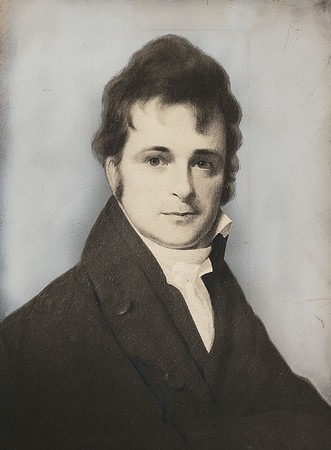Thornhill: Home of Frederick Bates, Missouri's Second Governor
Introduction
Text-to-speech Audio
Erected in 1819, Thornhill is the oldest home of a former Missouri governor in the state. The estate was the home of Frederick Bates who served as Missouri's second governor (1825) and territorial secretary for both the Louisiana and Missouri Territory. Bates also had two brothers in public service: Edward, who served as Abraham Lincoln's Attorney General, and James, Territorial Senator to the Arkansas Territory. From 1808 until 1824, Bates purchased land in the area along with enslaved persons whose labor enriched Bates and allowed him to expand his property to include the 1,000-acre farm known as Thornhill. The property was later occupied by the grandson of beer baron Adolphus Busch who donated the property to St. Louis County for use as a park and historic site.
Images
Thornhill: Governor Frederick Bates Estate

Governor Frederick Bates

Backstory and Context
Text-to-speech Audio
The Virginia-born Frederick Bates moved from Michigan to Missouri in 1807 when President Thomas Jefferson appointed him Secretary of the Louisiana Territory; Bates had previously served in the territorial government in Detroit.
Bates' appointment is often attributed to Jefferson's desire to have a trusted man in the position because he feared hostile political developments in the West owing to the actions of rivals like Aaron Burr. Jefferson eventually accused Burr of treason, and while Bates succeeded Burr's brother-in-law, Secretary Joseph Browne, the genuine political rift in Missouri occurred not between Burr and Jefferson but between Bates and territorial governor Meriwether Lewis of the "Lewis and Clark Expedition."
Lewis spent most of his time in the East, away from Missouri, allowing Bates to act as governor, ultimately undermining Lewis' power. Bates established trading and mining regulations, authorized land claims, and appointed friends to government jobs. Bates frequently wrote letters to President Jefferson with opinions about Lewis' inability to administer the new territory and accused Lewis of using government money for personal gain so it is no surprise that the two men clashed when Lewis arrived in St. Louis.
When Congress established the Territory of Missouri in 1812, Bates maintained the Secretary position and, just as he had done with Lewis, became acting governor during the frequent absences of Lewis' expedition partner, William Clark, who officially held the title of Missouri Territorial Governor. As a result, Bates continued to become a political force in Missouri. In 1824, a few years after Missouri became a state (1821), Bates defeated Lt. Governor William Henry Ashley in the gubernatorial race to become the state's second governor; he won with fifty-seven percent of the vote.
Bates purchased land near modern-day Chesterfield, Missouri in 1808 and, during the 1810s, Bates continued to add to his property. He eventually built the historic home on the property in 1819, and records note that he purchased slaves several times from 1812 to 1824 to support the farm that grew to around 1,000 acres by the 1820s. As governor, he split his time between St. Louis (at the Capitol) and his Thornhill home. However, his time as governor proved short as he died in 1825 from pleurisy, having served only nine months as governor.
The family buried Bates in the family cemetery on the Thornhill estate. The home remained in the family until 1884, when Bates' son, Lucas Lee, sold his portion of the land (ninety-eight acres) and the historic house. In 1930, beer magnate Adolphus Busch's grandson, Leicester Busch Faust, purchased the ninety-eight acres of land and home, which he kept until 1968 when he donated the hose and property to St. Louis County for use as a park and historic site, which remains its function today.
Sources
"Lewis & Clark National Historic Trail: Frederick Bates, Part 1." National Park Service. Accessed May 31, 2023. https://www.nps.gov/articles/frederick-bates-part-1.htm.
"Lewis & Clark National Historic Trail: Frederick Bates, Part 2." National Park Service. Accessed May 31, 2023. https://www.nps.gov/articles/frederick-bates-part-2.htm.
Marshall, Thomas Maitland, ed. The Life and Papers of Frederick Bates. St. Louis: Missouri Historical Society, 1926.
Raiche, Stephen J. "Thornhill." National Register of Historic Places. mostateparks.com. 1973. https://mostateparks.com/sites/mostateparks/files/Thornhill.pdf.
"Thornhill-1820s Home of Gov. Frederick Bates." Visit Missouri. Accessed May 31, 2023. https://www.visitmo.com/things-to-do/thornhill-1820s-home-of-gov-frederick-bates.
"Thornhill: Home of Missouri's Second Governor." St. Louis County Parks. Accessed May 31, 2023. https://stlouiscountymo.gov/st-louis-county-departments/parks/places/faust-park/faust-field-trips/thornhill-pamphlet-2022/.
Visit Missouri: https://www.visitmo.com/things-to-do/thornhill-1820s-home-of-gov-frederick-bates
National Park Service, https://www.nps.gov/articles/frederick-bates-part-1.htm
